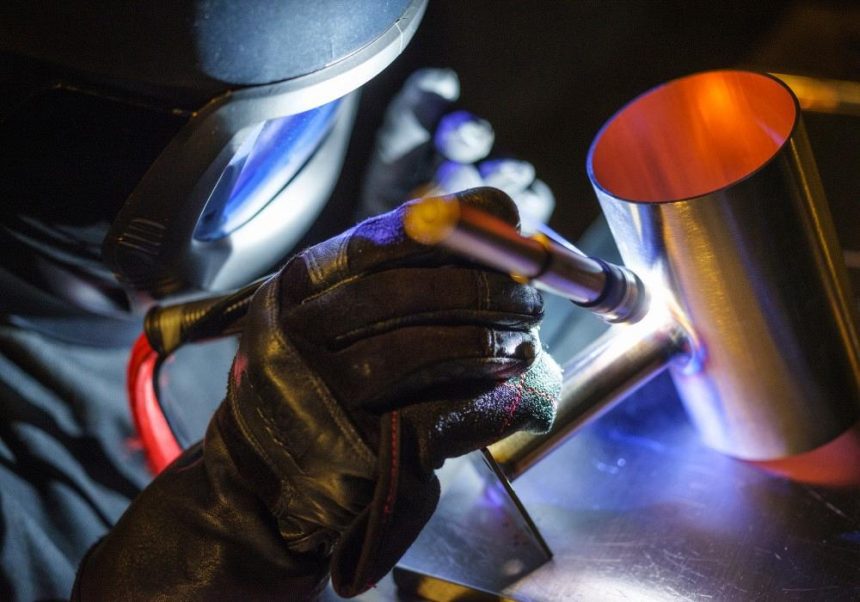TIG welding offers unparalleled flexibility and versatility compared to other welding methods. However, mastering TIG welding for project work can be quite challenging. Nonetheless, by investing extra effort and practicing diligently, individuals can enhance their proficiency in operating a TIG welder and seamlessly accomplish TIG welding tasks.
Are you new to TIG welding? Learn about the various applications of TIG welding with this beginner’s guide.
Welding Town
TIG welding, also known as Gas Tungsten Arc Welding (GTAW) or Tungsten Inert Welding, is an arc welding technique renowned for its ability to produce high-quality, pristine welds. It finds widespread application in projects where uncompromising quality is essential, such as nuclear, aviation, pharmaceutical, and food and beverage industries. In contrast to MIG welding, which employs a continuous feed of a metal coil through the welding gun, TIG welding involves manually introducing filler metal into the molten pool, which can lead to the base metal melting. Consequently, TIG welding can be performed on various base metals, including stainless steel, aluminum, carbon steel, and other non-ferrous metals.
When it comes to becoming an exceptional TIG welder, there’s no better advice than to cultivate a high level of patience and dedicate yourself to consistent practice. This invaluable guidance has worked wonders for us, and we have adopted it as our motto, encouraging aspiring TIG welders to follow it from the very beginning. However, if the mere thought of holding a welding torch fails to ignite your passion, we recommend exploring alternative welding methods, as pursuing a TIG welding career may not be the ideal choice for you.
While we understand that TIG welding can be challenging, we want to encourage individuals who are truly passionate about it to pursue it as a career. In order to support our new welders, we are delighted to share some invaluable tips and tricks that will aid in their learning process, skill improvement, and overall progress. By incorporating these tips into your daily routine, you will gain confidence, achieve a consistent arc, exercise greater control over the weld puddle, and consistently produce outstanding welding results.
Here are 15 essential tips to help beginners excel in TIG welding:
These simple yet effective techniques can significantly streamline your welding tasks, ensuring timely completion and making your life easier.
1. Weld by using the minimum power source
Begin with minimal power: When starting your TIG welding journey, it is crucial to start with the minimum power settings. Ensure that you direct the minimum power into the weld puddle. Remember, TIG welding relies on achieving proper penetration. Providing excessive power will result in the base metal burning too quickly. Therefore, maintaining an appropriate power level is a vital aspect of your welding technique.
2. Keep your metals clean
Ensure clean metal: A crucial aspect of TIG welding is working with clean metal. Without a clean surface, it is challenging to create a solid weld or maintain a stable arc. It is highly recommended to have a dedicated brush for cleaning purposes. Before starting a new project, invest a few extra minutes in thorough cleaning, as it can yield remarkable outcomes.
3. Using the correct tungsten
Selecting the appropriate tungsten: When working with different materials using a TIG welder, it becomes evident that you need to use different types of tungsten electrodes. For instance, when welding aluminum, it is common to use green tungsten electrodes, while red tungsten electrodes are commonly associated with steel. There is no need to be overwhelmed and memorize all the details right away. With practice, you will gradually develop a deeper understanding of the equipment and its requirements for specific materials.
4. Thickness of Tungsten must be considered
Consider the tungsten thickness: Experienced TIG welders emphasize the significance of tungsten thickness. If the tungsten is too large, it will require more heat to initiate the process, especially when striking the arc. Conversely, if the tungsten is too small, there is a risk of overheating the base metal and compromising the integrity of the welds. Therefore, carefully consider the appropriate tungsten thickness for each welding task to ensure optimal results.
5. Identify the time to regrind your tip
Recognize when to regrind the tungsten tip: It is crucial to monitor the condition of the tungsten tip to ensure proper contact with the weld puddle. Over time, the tip may develop a ball shape, resulting in a subpar tungsten arc. Since maintaining high quality is paramount in TIG welding, it should never be compromised. If you notice the tip causing negative effects on the weld quality, consider it a warning sign and take it seriously. Regrinding the tungsten tip to restore its smoothness becomes necessary. Additionally, there is a risk of accidents when working with a balled tip. To save time, always keep several prepared tungsten electrodes on hand.
6. Keep consistent during the welding process
Maintain consistency throughout the welding process: TIG welding demands unwavering focus from start to finish. Ensure that you have eliminated any distractions in your welding environment that may cause disturbance or interruptions during the process. It is also advisable to keep extra filler rods within close reach, allowing you to seamlessly continue your workflow without introducing unnecessary breaks. By maintaining consistency, you can achieve better welding results and minimize potential disruptions.
7. Equip with the proper safety equipment while grinding
Use proper safety equipment while grinding: It is crucial for beginners to understand the importance of safety precautions in TIG welding. While TIG welding itself produces minimal spatter, sparks, fumes, or smoke, it is essential to note that tungsten electrodes are slightly radioactive, especially when grinding to create a fine tip. Therefore, wearing a welding respirator specifically designed to protect the airway is imperative. Additionally, choose a workspace with minimal dust and dirt accumulation and ensure a safe storage place for your TIG welder to protect the tungsten tip. Adequate ventilation within your workspace is also important for regular welding operations. Prioritizing safety ensures a healthy and protected welding environment.
8. For your electrode grinding stay consistent
Maintain consistency when grinding electrodes: Consistency is crucial, especially for beginners, when it comes to grinding tungsten electrodes. Opting for a lengthwise grinding approach is a smart choice, as it helps create an even result during welding. While more experienced TIG welders may use a tungsten sharpener, beginners are advised to use a bench grinder, which can yield excellent results. With the wide range of options available, it is important to choose a method that allows you to grind your electrodes without introducing contamination. By prioritizing consistency in your grinding technique, you can achieve better welding outcomes.
9. Get to know about your shielding gases
Familiarize yourself with shielding gases: In TIG welding, 100% argon is commonly used as a shielding gas. Additionally, a popular option among welders is a mixture of 75% argon and 25% helium. It’s important to understand that increasing the helium content in the shielding gas decreases the temperature, which can create challenges in striking the arc properly. If you use 100% helium as a part of your shielding gas, you may find it more difficult to initiate the welding process. During the learning phase of TIG welding, it is recommended to set your shielding gas flow rate at 15-20 cubic feet per hour. Setting it higher can potentially disrupt your weld. Take the time to familiarize yourself with different shielding gas options and their effects to optimize your TIG welding performance.
10. Whenever possible use bigger rods
Use larger rods when possible: The logic behind using larger rods in TIG welding is quite straightforward. With a larger rod, you will experience greater ease in the feeding process. While the standard rod diameter in TIG welding is typically 3/32 or smaller, opting for a 1/8 inch diameter rod can provide added convenience when learning the welding process. Using a larger rod size can make it simpler to handle and manipulate the filler metal, enabling smoother and more controlled welds.
11. Angle of your rod and torch shouldn’t be the same
Maintain different angles for your rod and torch: It is important to avoid placing the rod and torch at the same angle while working with TIG welding equipment. When they are aligned at the same angle, the heat tends to “bounce” during the welding process. This can cause the rod to melt prematurely before desired, resulting in an inferior bead. To prevent this, feed the rod into the welding pool at a separate angle, allowing for proper melting and a more satisfactory weld bead.
12. Instead of an abrupt end, slowly reduce your arc
Gradually reduce your arc instead of abruptly ending it: When using TIG welding with a defined temperature, it is advisable to keep the foot pedal or any temperature control mechanism around 3/4th of the way down. This provides you with the ability to let the arc trail off smoothly as you reach the end of the weld. Abruptly shutting down the welder machine can lead to a higher risk of base metal cracking. By gradually reducing the arc, you ensure a controlled and controlled cooling process.
13. MIG and TIG are often interchangeable
Interchangeability of MIG and TIG: It is not uncommon for welders to occasionally use wire from MIG welding to create a TIG weld. While this may not be a regular practice, there are instances where welding equipment can be interchanged. Many multi-process welding machines offer the capability to perform both MIG and TIG welding, making them versatile tools for various welding needs.
14. Protect yourself from shocking
Protect yourself from electrical shocks: One of the simplest and most effective ways to reduce the risk of electrical shocks during welding is to create a non-conductive environment. You can achieve this by placing non-conductive materials on surfaces where you rest your arms or hands. Welding gloves are commonly used to protect against electrical shocks, as they provide a barrier between your skin and the electric current. Additionally, using wood products as a resting surface is another viable option. It is important to be aware that sweat can conduct electricity, so taking breaks and wiping off excess sweat is crucial. By taking precautions and maintaining a non-conductive environment, you can minimize the risk of electrical shocks.
15. Thin gloves sometimes work great with TIG welding
Thin gloves for better TIG welding control: When it comes to TIG welding, using thin gloves on the hand that feeds the rod can provide several advantages. Thin gloves offer a more realistic and improved tactile sensation during the welding process. In contrast, bulky, thick, and heavy gloves can hinder your control over the welding process and affect the overall quality of the results. By using thin gloves, you can have better control and feel of the rod, allowing for more precise and accurate feeding. This enhances your learning experience and helps you develop a realistic technique of feeding the rod using your fingers.
Top 15 Useful TIG Welding Tips for Beginners
Welding Town
Frequently Asked Questions (FAQs)
1. How do I fetch better value at TIG welding?
Improving your TIG welding skills takes practice and dedication. Weld as often as possible to hone your technique. Consider finding a welding partner to practice with and learn from each other. Take advantage of online resources, tutorials, and welding classes to gain valuable knowledge and improve your skills.
2. How do you practice TIG welding?
There are several ways to practice TIG welding. One effective method is to find scrap pieces of metal and practice welding different types of joints. You can also create mock projects or take on small welding tasks to apply your skills and gain experience.
3. Is TIG welding the most difficult to learn?
No, TIG welding is not considered the most difficult welding process to learn. In fact, it is often regarded as one of the easier processes to master. Compared to other welding methods, TIG welding generally involves lower heat input, resulting in less distortion and warping of the material. With proper training and practice, you can become proficient in TIG welding.











